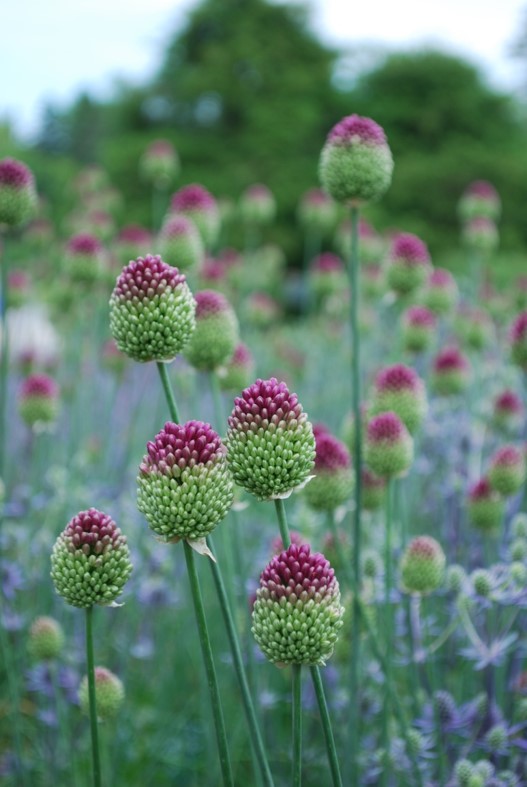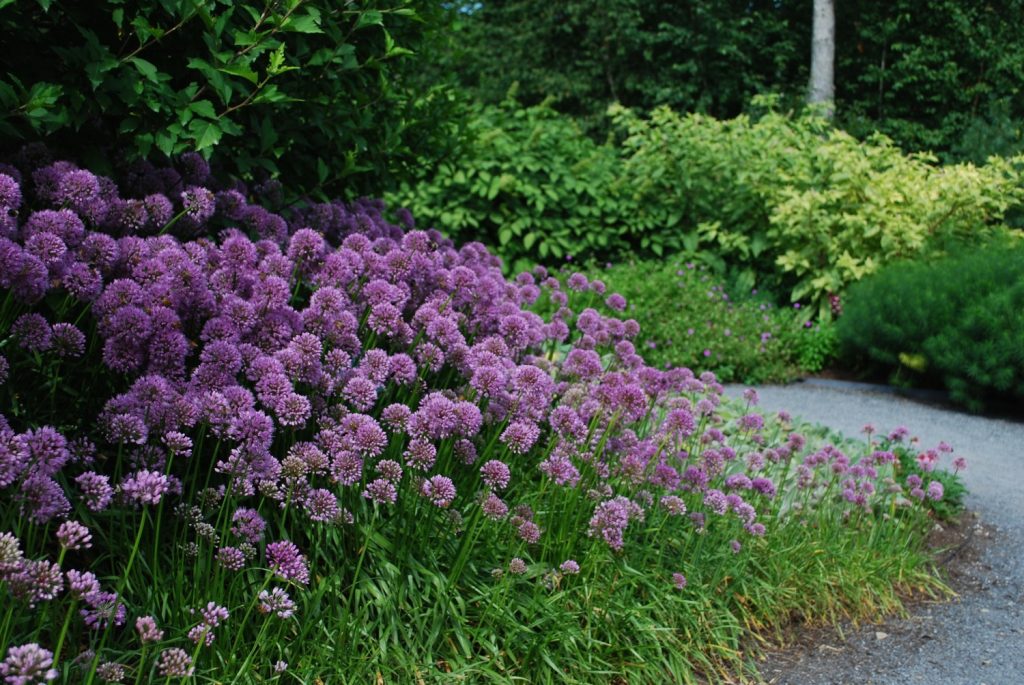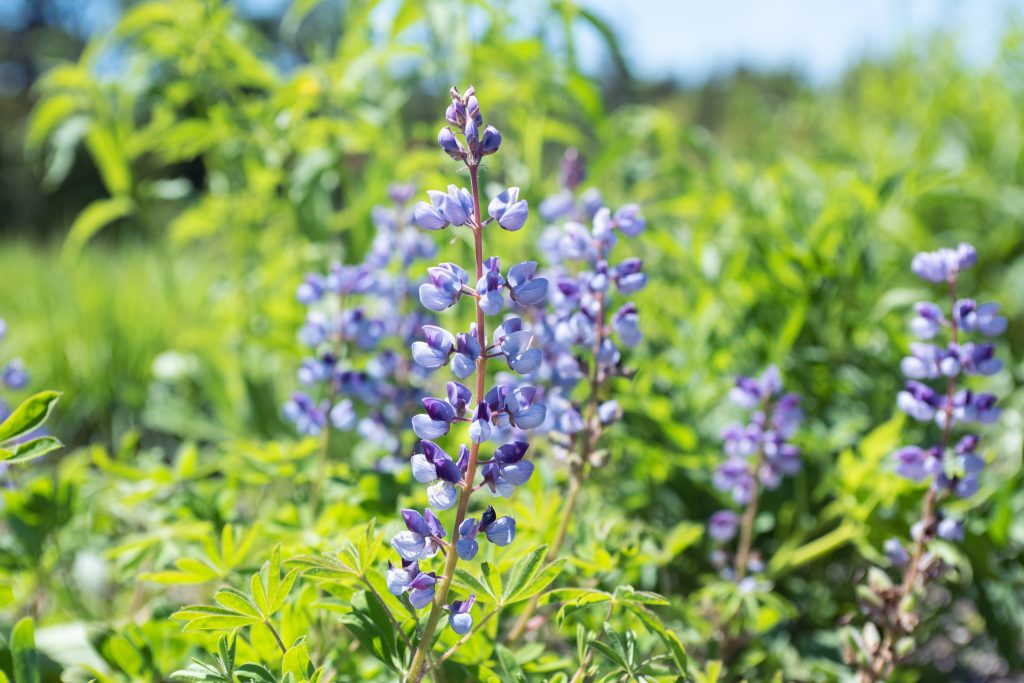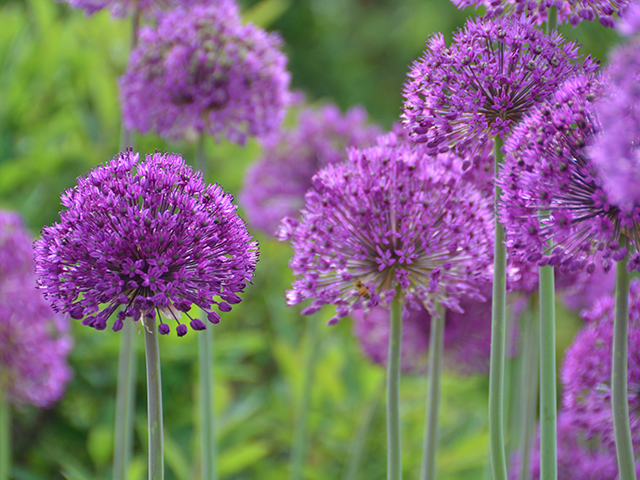Alliums are Popping at the Gardens
Yesterday, I was looking through plant catalogs and found even more species and cultivars unknown to me that I can’t wait to add to the Gardens. They are becoming more and more popular as people realize how versatile they are and how many pollinators they attract. Most alliums are easy to grow in full sun and well-drained soil, and with so many different ones to choose from, you can have allium flowers for months.
One of the first alliums to bloom is Allium karataviense. At the Gardens, we have the cultivar ‘Red Giant’, which has proved itself as a standout from the rest. Topping out at 8-12 inches, it’s one of the shorter varieties, but it has massive leaves which hold up better than others and showcase the beautiful red/purple bloom. One of the next standouts is the hybrid ‘Pinball Wizard’; they have big beefy stems to hold up big 6-inch blooms. (Be sure to check them out in the ledge bed of the Great Lawn.)
Elsewhere around the Gardens we have plenty of ‘Gladiator’, ‘Globemaster’, and ‘Mount Everest’ blooming now too. The bigger alliums can have unsightly foliage, so be sure to plant them with other perennials to hide that. One of the favorites is just starting to bloom—Allium christophii, or star of Persia. It has grey/green fuzzy foliage with massive 8-inch blooms and stands 12-18 inches tall. It looks phenomenal with Amsonia ‘Blue Ice’ or Veronica austriaca subsp. Teucrium, ‘Crater Lake Blue’.
Another standout for me is Allium ‘Yellow Fantasy’, which blooms mid-June and has unique yellow/chartreuse, firework-type flowers. ‘Yellow Fantasy’ has strappy, chive-like foliage which holds up fairly well and can be mixed with other perennials. A bit later in the summer another, more common (but still special) option is ‘Drumstick’ allium, Allium sphaerocephalon. They have stunning, dark purple blooms on wispy 2–3-foot stems, and bloom for two weeks. I find they are best mixed with other perennials and will seed around when happy.
All of the above allium bulbs can be purchased online and planted in the fall; the varieties below can be found at garden centers and planted in spring/summer.

We have many summer-blooming alliums, such as ‘Millennium’, ‘Summer Beauty’, ‘Medusa’, and ‘Lavender Bubbles’, to name a few. These are clump-forming alliums with masses of 1-2-inch blooms atop succulent green foliage. ‘Medusa’ is unique—its foliage is grayish with a twist. An allium that I discovered after working at the Gardens is Allium ‘Hair’. It’s a really funky variety that grows similarly to drumstick allium, but with unique flowers that look like someone after they stuck their finger in a light socket. They have a purple interior with green twirly petals surrounding the interior—this is a must-have for the gardener who has everything!
The final allium to bloom in the season is Allium thunbergii, ‘Ozawa’, whose beautiful dark purple blossoms rise above grass-like foliage. Unlike many other alliums, the foliage of ‘Ozawa’ remains attractive all summer, making it a great choice as an edging plant.
One final note: while alliums for the most part deter deer and rabbits, if you find you’re having pest issues, try Liquid Fence. It’s safe to use and can be found at stores like Home Depot.

I hope this inspires you to get out and see all the different alliums gracing the Gardens and your neighborhoods—add some to your landscapes as well!
Brent McHale is a Horticulturist and Gardens Aglow Program Manager at the Gardens.


